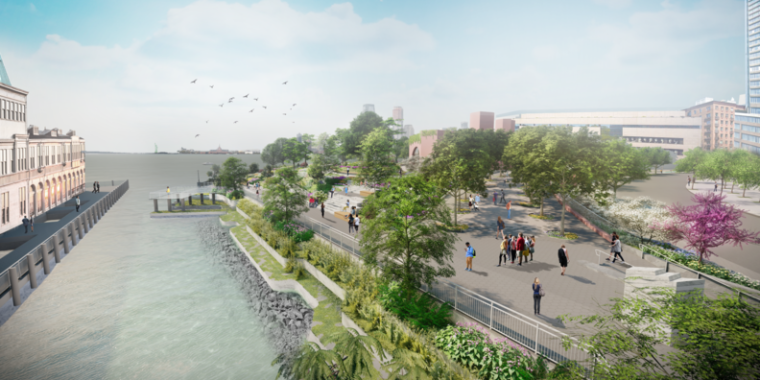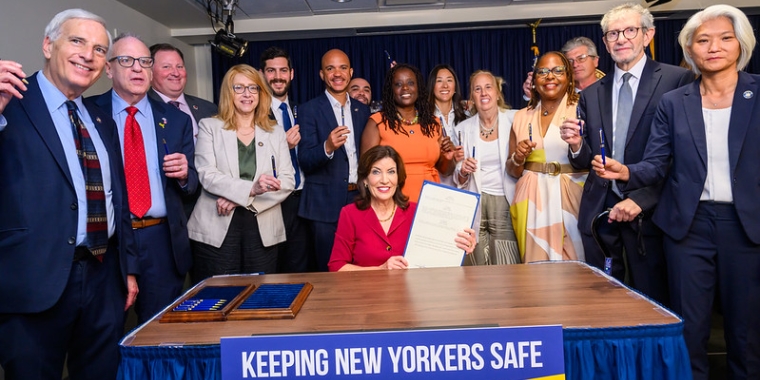
Battery Park City resiliency project gets eleventh-hour boost to greenspace

A $231 million resiliency project in Lower Manhattan is getting a major last-minute design change to expand the plan’s lawn space at Wagner Park, after the greenspace is rebuilt 10-feet higher than it is now to help protect the area from storm surge and sea level rise.
The Battery Park City Authority has revised its plan to fortify the neighborhood from flooding, less than two months before construction is set to break ground. The revised plan will add 12,800 square feet of lawn space to Wagner Park—a 74% increase from the South Battery Park City Resiliency Project’s previous design.
Changes to Wagner Park, currently a 3.5-acre waterfront space with a lawn and esplanade that boasts views of New York Harbor, comes following years of community engagement on the plan and calls from locals to boost the amount of greenspace.
“A really important part of this process for us has been balancing the urgent need for resiliency with the value derived from incorporating community voices and concerns,” B.J. Jones, the president and CEO of the Battery Park City Authority, told Crain’s. “We heard the community loud and clear about the value of lawn space in particular and took that seriously.”
Jones detailed those changes in a Monday letter to City Council member Christopher Marte, State Senator Brian Kavanagh and Manhattan Borough President Mark Levine, who had penned a joint letter to the Authority last week emphasizing community concerns about a lack of lawn space, the scale and use of the Wagner Park pavilion and the need for community engagement throughout the project’s construction timeline.
A key component of the coastal protection plan is to bulldoze Wagner Park and elevate it more than 10 feet, similar to the approach the East Side Coastal Resiliency Project is taking with East River Park. The main difference being—so far at least—that community concerns with the project and its approach to Wagner Park have been muted compared to the lawsuits and raucous protests on the east side (demonstrators went so far as to chain themselves to a tree outside of City Hall in September over the east side project).
But the Wagner Park project isn’t absent of dissidents. The Battery Park City Neighbors Association is hosting a Tuesday rally against the reconstruction over concerns with the lawn space, a loss of trees and an increase in the size of the park’s pavilion.
The Battery Park City authority has sought to avoid such pushback by seeking to keep residents and the local community board in the loop about the project for the last seven years, along with alterations to the plan based on neighbors’ input. The last-minute boost to lawn space at Wagner Park is an example of this.
Tammy Meltzer, the chair of Manhattan Community Board 1, is in the midst of digesting the changes and did not immediately respond to a request for comment. Alice Blank, an architect who is the board’s vice chair, said she is also reviewing and learning more about the changes but found the authority’s responsiveness to locals’ input encouraging.
Amy Chester, the managing director of Rebuild By Design, a federal effort launched in the wake of Sandy, said “broadening of the green space is huge,” adding that it’s something the community has long sought. That excitement was echoed by State Senator Brian Kavanagh who said he appreciated that the authority went back to the drawing board. Manhattan Borough President Mark Levine said the change means the project better reflects the community’s needs. Other local officials say they’re generally pleased with the changes but wonder what took the authority so long to react to residents’ greenspace complaints.
“I don’t think it should have taken this long for us to get the maximum amount of lawn space, but I think this is a step in the right direction and this is a good faith action by the authority board,” City Council Member Christopher Marte, who represents Lower Manhattan, told Crain’s. “We’re happy to continue to work with them to deliver on what the community wants.”
That includes ensuring that the new three-story pavilion in Wagner Park, which is replacing the current low-rise red-brick pavilion, has a community centric use. Currently, it’s expected to feature a restaurant along with community space, an education center, and public restrooms. The authority says it aims to issue a request for expressions of interest from potential restaurant operators for the space within three months. Major changes to the pavilion’s design, Jones wrote, are unlikely because they “would require significant revision and delay to the project, we do not believe it would be prudent to alter the design of the Pavilion building at this time.”
Wagner Park will close for two years when construction begins, which the authority anticipates for early October. Work on the park will not be completed in phases to give the community access to part of the greenspace. Officials expect renovations to be complete by March 2025.
The new lawnscape sacrifices 7,000 square feet of hardscaped paths, originally included to ensure universal accessibility throughout the elevated portion of the park. But the project’s design team was able to enlarge the law while maintaining smaller gardens and allow part of an existing walkway to allow for accessibility to the space. The change will also add ten more trees to Wagner Park, for a total net increase of 126 trees compared to the park today.
“We don't believe that there's any sacrificing or compromising the universal accessibility of the park,” Gwen Dawson, Battery Park City Authority’s vice president of real property told Crain’s “nor the means of circulating pedestrians around the lawn area.”
Some residents are encouraged by the changes but remain cautious, particularly since Wagner Park was not majorly flooded during Sandy compared to other stretches of the battery, said Daniel Akkerman, president of The Battery Alliance.
“I think it is a good step forward. But I still would still argue there’s more that needs to be done,” said Akkerman. “We're throwing a lot of money at an area that was not flooded. We need to ensure we’re really accounting for where the flood risks are.”


